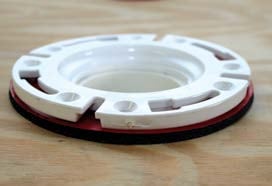Story of the Closet Flange Gasket
Customer-driven design has long been a hallmark of our approach at STI. I was explaining this to members of our team recently when I recounted the story of the “Closet Flange Firestop Gasket” and how it came to be.
Back in 2006, we visited a jobsite in New Brunswick, NJ, a short distance from our corporate headquarters. The plumber on a new hotel project was encountering an issue and wanted some technical advice. The plumber explained that they had cast iron drain pipes for the toilets penetrating through concrete floors. After the cast iron pipes were sealed with firestop caulk, the plumbers would come back to install a water closet flange and toilet.
The issue they encountered was that when they caulked the cast iron pipes on top of the floor, they had to recess the caulk to accommodate the toilet flange. Despite best efforts to keep it relatively clean, the dried caulk would inhibit their ability to set the flange properly and they would invariably end up having to remove some of the excess caulking with knives or wire brushes.
To resolve the issue, they decided to seal the cast iron drain pipes from below using ladders or scissor lifts for access to the openings. Unfortunately, this proved to be more time consuming due to accessibility issues and physically trying to keep the caulk in place when applied to the underside of the opening.
Seeing the customer’s attempts first-hand made us quickly realize that there was indeed a better method. We told our customer we had a solution in mind, but we needed a little time to work through the intricacies. On our way back to the office, we stopped at a plumbing supply house and bought one of every closet flange they had in stock. Using some of our thin, intumescent rubber material, we mocked up what would become the STI Closet Flange Firestop Gasket and began to replicate the installation we witnessed onsite. Seeing that it was indeed easier to place the gasket either onto the drain pipe stub or directly to the bottom of the toilet flange, we knew we were onto something. The added benefit was that the gasket was soft and resilient enough to accept installation of the flange bolts and the poly finish was resistant to wax and other substances. We filed patents, produced a prototype, and circled back with our customer. Our customer was immediately keen to the new solution.
Customer-driven design begins with being focused on the customer and on his or her needs. We could have shrugged our shoulders and walked away, but instead we decided to focus our efforts on working to find a better solution. It helped to have that customer input to perfect our original prototype and that allowed us to take a mere concept and make it a reality.
Today, we sell a great many of those gaskets, and we have expanded the testing to include drain pipes made from PVC and ABS and testing to other global standards, including CAN/ULC-S115. A simple problem on one jobsite truly became the impetus behind a patented product sold all over the world. That is the power of customer-driven design.






